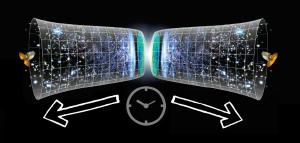Blog
Time’s Arrow
12 June 2015
 NASA / WMAP Science Team
NASA / WMAP Science TeamYesterday I talked about how time can be symmetrical in physics. For example, a video of billiard balls colliding looks the same whether played forwards or backwards. This would seem to contradict our everyday experience that time flows ever onward in one direction. We can remember yesterday, but not tomorrow, and if we break our favorite coffee mug we can’t simply unbreak it. This unidirectional nature of events is called the arrow of time, and it’s a bit of a mystery.
In classical Newtonian physics, interactions between simple particles is perfectly time symmetric. Where the direction of time appears is through thermodynamics. For example, if you had a room full of air, with all the air molecules bouncing around, it is very unlikely that all the molecules would at one point clump together in one corner of the room. It’s theoretically possible that all the air molecules happen to have the right trajectory to reach the corner at about the same time, but it’s extremely unlikely. On the other hand, if you started with a pressurized container of air in the corner and then released the air, the molecules would almost certainly spread evenly throughout the room given a bit of time. If you think of these examples as time-reversed siblings of each other, you can see that both are possible, but one is far more probable than the other.
We can express this difference in probability in terms of entropy. The pressure, temperature and volume of the gas in the room is known as its state. Since these are determined by the positions and speeds of all the air molecules in the gas, which is collectively called the microstate of the gas (the state of all the microscopic particles). For a given state of the gas, there are lots of ways the atoms could be moving and bouncing around. As long as the average motion of all the atoms is about the same, then the pressure, temperature and volume of the gas will be the same. This means there are lots of equivalent microstates for a given state of the gas. The more microstates for a given state of the gas, the greater the entropy of the gas, and the more likely the gas will be found in that state. So the arrow of time can be stated as the direction of increasing entropy. This is often expressed as the second law of thermodynamics, which states that the entropy of a system can never decrease.
In quantum theory the arrow of time can be expressed in other ways. In the simple Copenhagen interpretation of quantum theory, a quantum object is in a probabilistic state defined by a wavefunction, which then collapses into a definite state when observed. This collapse of the wavefunction is not reversible, and thus there is a single direction to time. In many ways the Copenhagen interpretation is overly simplistic, but the idea holds in other interpretations as well. For example, quantum systems left to themselves become more entangled over time. So another way to express the arrow of time is to say that it is in the direction of increasing entanglement.
Of course none of this addresses our most direct experience of time’s arrow, which is that we seem to have a conscious experience of the unidirectional flow of time. It’s so deeply ingrained in our personal experience that we intuitively feel that events occur at a specific “now” even though relativity clearly disproves a cosmic present moment. Just why we have such a strong experience of the arrow of time isn’t clear.
But given time, we might be able to figure it out.